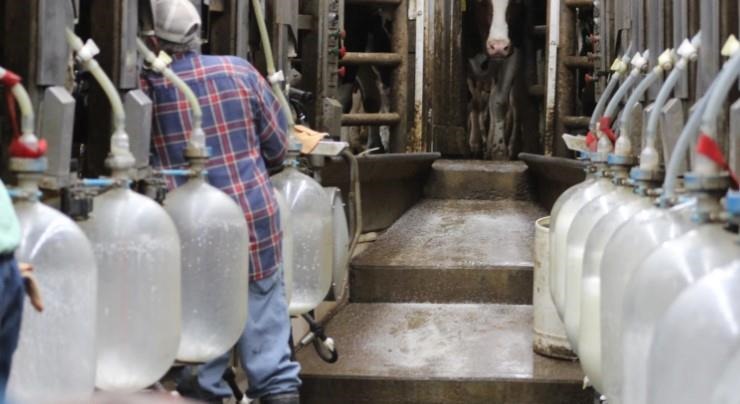By Abagael Giles and Mike Dunn
Cows release a super potent greenhouse gas when they burp and also when their poop breaks down. It’s called methane and a lot of farms in Vermont and around the country are trapping it to make electricity or natural gas.
Vermont Public partnered with NOVA to find out how it all works.
The James family has been milking cows — and bottling that milk — at their farm in Weybridge, Vermont since 1930. Today, they milk about 540 Holsteins, and the fourth generation is getting ready to take over the business.
On a chilly spring day, Bob James gave us a tour.
“It’s a free stall farm, so cows can get up, walk around, eat, drink, sleep whenever they want,” he said, as we walked through one of the barns.
Even though this is a small farm by national standards, all of those cows produce a lot of waste. But at Monument Farms, that waste has a second and even third life. They use it to make electricity and bedding for the herd.

Abagael Giles
The milking parlor at Monument Farms.
That’s thanks to something called an anaerobic digester.
“A digester is … it’s like a pet, in a way. I tell people and they don’t understand,” James said. “But it’s a living thing in there.”
How a biodigester works
As much of the cow manure as possible gets scraped from the barns and fed into a big airtight tank.
“Ours is a concrete tank, like an underground swimming pool that's capped off, there's no oxygen in it,” James said.
It takes about a month in there for naturally occurring bacteria to eat up the bits of haylage and grain in the manure that the cows’ stomachs missed. In fact, the process is very similar to what happens in a cow’s stomach.
All that eating produces a methane-rich gas called biogas.
The gas gets siphoned from the tank into a very cold pipe. It cools really quickly, and all the water in the gas condenses, so it drops out like dew.
“The gas then goes through a pressurized pump that feeds, in our case, the engine,” James said.
That engine burns the gas to make electricity, which gets sent into the grid. In return, Monument Farms gets a credit on their electric bill.
The electricity is considered renewable — in Vermont and by federal standards.
To be clear, that doesn’t mean biodigesters that are used to create electricity don’t also create planet-warming emissions.
Biodigesters, like the one at Monument Farms, take one super potent greenhouse gas — methane from cow waste — and burn it to make a less potent greenhouse gas — carbon dioxide — when they make electricity.

Burning biogas captured from manure creates carbon dioxide and water.
In the short term, methane has 80 times the warming power of carbon dioxide.
The climate impacts
Before Monument Farms had a biodigester, they let their manure sit in a lagoon, where bacteria broke it down into nitrogen-rich fertilizer in the open air. Methane that now gets trapped in the digester was going into the atmosphere.
Joe Rudek is a scientist with the Environmental Defense Fund.
“Studies have shown that given the potential that we currently have for reducing methane from oil, gas and from livestock, we could avoid a quarter of a degree Celsius of warming by mid-century, which is very significant,” Rudek said.
According to the Environmental Protection Agency, agriculture as an industry is responsible for almost as to much of America’s methane emissions as fossil fuel extraction and processing, and coal mining.
States like California and Oregon, as well as Vermont, are trying to make it profitable to capture methane.
Treating methane as an energy source is one way to do that.
But some experts say there’s a risk in that, because you might incentivize farmers to farm in a way that produces more methane rather than less.
Tom Richard is a professor of agricultural and biological engineering at Pennsylvania State University. He says ideally, these policies would result in a net reduction in methane emissions.
“If we're trying to mitigate climate change, and people are investing money, whether that's through incentives for renewable energy or, or carbon sequestration in a forest or some other form, they want to make sure that that new funding and that investment, and that incentive, is actually getting people to do something different than they would have done otherwise,” Richard said.
Click here to see more...